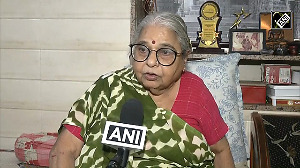When RV, the car racer from the movie Tara Rum Pum, has a fateful accident, his whole life changes. His inability to continue racing after the accident leaves him penniless. He loses his home, for which he had taken a loan, and all his possessions.
In reality, it could happen to anyone (of course, in a much lesser magnitude). Things could go terribly wrong due to some medical emergency or job retrenchment. It could also be the result of poor money management.
With easy credit available, the lure to spend beyond one's means has also led to many people finding themselves un-able to repay loans, which is leading to increased defaults.
For example, HDFC Bank has curtailed two-wheeler loan disbursement in Uttar Pradesh, North Karnataka, Rajasthan and Haryana. SBI Cards, the second largest credit card issuer in India, has run up a net loss of Rs 186.61 crore (Rs 1.87 billion) in the quarter ended December. Reason: customer defaults.
A recent study by rating agency Crisil suggests that gross non-performing assets in retail loans are likely to increase to 4 per cent over the next two years, from 2.7 per cent as of March 2007. While the figure is not alarming, it definitely signals the possibility of an increase in defaults.
The other side of the coin is the borrower who is not able to repay the loans. The inability of borrowers to communicate their financial issues to their lenders only adds to their mounting debts. As a result, borrowers continue to borrow to pay off their existing debts and find themselves in a vicious cycle. Debts keep mounting and so does creditor harassment.
Spotting bankruptcy
Says Gaurav Mashruwala, a Mumbai-based financial planner: "At the time of repayment of loan, if one does not have the money or assets that can be liquidated, then the individual is bankrupt."
To get out of this situation, the debtor has to seek help at the right time and from the right source. "Unfortunately, this does not happen and a person realises he is in deep trouble only when he reaches a point of no return," says S Rangarajan, a counsellor at the Chennai centre of Abhay, a credit counselling trust sponsored by Bank of India.
How to exit a debt trap
Get Help.There are a few credit counselling centres operating in the country over the last 18 months. Other than Bank of India's Abhay, Disha is another trust, which is sponsored by ICICI Bank. The number of such counselling centres is bound to increase as the Reserve Bank of India has taken initiatives to spread and formalise the credit counselling mechanism in the country.
Legal recourse
A person who is bankrupt and is way out of the purview of credit counselling can consider legal recourse. But many hesitate. "This is because of ignorance and social and economic boycott that a person suffers," says Mumbai-based consumer lawyer Anand Patwardhan. "This should be the last resort as it has long lasting repercussions," warns Lovaii Navlakhi, managing director and chief financial planner, International Money Matters, a financial planning firm.
Who can file for insolvency?
The debtor (borrower), through his legal advisor, has to file a petition to the concerned insolvency court to declare him insolvent. He can do this if he is unable to pay his debts when due, when he is under arrest or imprisonment in execution of the decree of any court for the payment of money, or when an order of attachment is subsisting against his property.
Similarly a creditor, who has a decree or an award of recovery of a certain amount, can also file a petition against the debtor in case his assets are not enough to pay off the debt. The insolvency laws protect the debtor from harassment by all creditors and the creditors get equitable distribution of the debtor's assets.
The law on insolvency is contained in two enactments - Presidency Towns Insolvency Act, 1909 (which applies to erstwhile presidency towns of Calcutta, Madras, and Bombay of British India) and, Provincial Insolvency Act, 1920 (which applies to the whole of India except the presidency towns mentioned above). Both Acts are similar in content.
Property treatment
When a debtor is declared insolvent, his property vests with the receiver or the official assignee (who is assigned by the court) for the purpose of distribution among the creditors.
He will receive master summons from the court stating when he has to submit his tax papers, bank statements, ledger book, cheque book and all other documents that would prove his net worth.
This will be handed over to the official assignee or receiver who will take charge of the assets, evaluate them and realise them for distribution.
Property would include anything that is in the debtor's name - house, car, shares or any other investments that can be converted into cash. In case the debtor acquires a property, wins a lottery or receives an inheritance during insolvency proceedings and before he is discharged, even that would be used for the purpose of distribution among the creditors.
Debt treatment
Once insolvency proceedings are on, the court will publish the matter of insolvency in its official gazette and local papers so that all creditors have a chance to get their claim. If they do not come forward to claim their share, once the insolvent is discharged, he is under no obligation to pay any creditor(s).
Debts that a creditor can prove to the satisfaction of the official receiver or assignee will be taken into account. There should be books of accounts and banking transactions that can prove the debt. Claims will be scrutinised for genuineness.
Interest takes the last priority in the order of repayment. Moreover, it will be at the rate recognised by the court, usually around 6 per cent. In case of default in credit card payment, the court will not recognise the rate of 36-42 per cent that many credit card companies charge towards late payment, default and so on.
Settlement procedure
After deducting the court's expenses for realisation of money out of the assets, it will be distributed rateably among the unsecured creditors (who have given loans without backing of assets). The secured creditor will first have to realise the security (that is, sell the asset) and for the unrealised balance claim as an unsecured creditor out of the funds realised by the official assignee for payment.
In most cases, the assets of the insolvent cannot satisfy all the debts. So the percentage of the settlement to the creditors will depend upon the amount realised by the official assignee.
Take a case of an individual whose debts have mounted to Rs 1 crore (Rs 10 million), out of which Rs 30 lakhs (Rs 3 million) is secured loan. His total assets are worth Rs 40 lakh (RS 4 million) (house, car, shares and other investments). Rs 30 lakh (Rs 3 million) will be claimed by the secured creditor from the total asset value and the remaining Rs 10 lakh (Rs1 million) will be rateably distributed to all the other unsecured creditors like credit cards payments, personal loans and so on.
Says T C A Shrinivasan, a Chennai-based advocate and a retired professor from Dr Ambedkar Government Law College, Chennai: "If the official assignee has reason to believe that there is scope for further payments from the debtor, then instead of an absolute discharge, only a conditional discharge will be given to the insolvent. The debtor might be directed to settle the dues out of his future earnings. These factors are, however, decided on a case-to-case basis."
Disqualifications of an insolvent
On being declared insolvent, you can neither be a director of a company nor a partner in a firm. You are disqualified from contesting elections or holding any public office. You are also debarred from entering into any contract or agreement. Professional bodies like the Bar Council may also prohibit you from practising if you are declared an insolvent.
An insolvent will not be given credit by any public or finance institutions until the order of insolvency is set aside by the court. S. Vasudevan, senior partner at Chennai-based legal firm Vasudevan & Associates, says, "There are, however, instances where a close relative or friend may contribute for his sustenance. This may not be treated as an income of the insolvent."
These disqualifications are removed when he obtains an order of discharge from the court.
Back to normal
To enable one to start his life afresh, the law on insolvency provides for the discharge of an insolvent from the state of insolvency. This is the last stage of the proceedings and it releases the debtor from all the debts provable in insolvency.
For this, the insolvent has to apply to the court seeking permission to annul the insolvency. Once the court is satisfied with the debt repayment, it will release him from the state of insolvency. This process, however, can be very lengthy and time-consuming.
Says Vasudevan: "If an insolvent intends to resume normal life, he will have to apply to the court seeking permission to continue his livelihood and give an undertaking that out of the future earning, he would contribute to discharge the balance debt due to the debtors whose claims have not been fully settled out of the estate realised by the official assignee or receiver. The court will impose a condition that out of his monthly earnings, he must deposit a major portion towards the balance debt and that he can take a portion for his sustenance."
There certainly is a lack of knowledge among debt-trapped borrowers about the recourses available to them, be it credit counselling or legal recourse. While the RBI has stepped up measures to increase awareness and formalise credit counselling in the country, very little being done on the legal front.
The stigma attached to bankruptcy appears to be taking an upper hand over the recourse it offers to 'genuine' debt trapped individuals. Definitely, a defaulter cannot be rewarded for his defaults. But there has to be a mechanism to help the lender and the borrower out of their tight situation.




